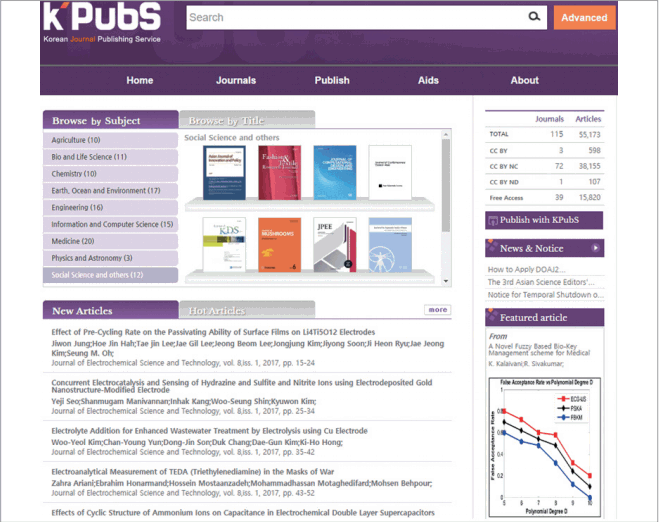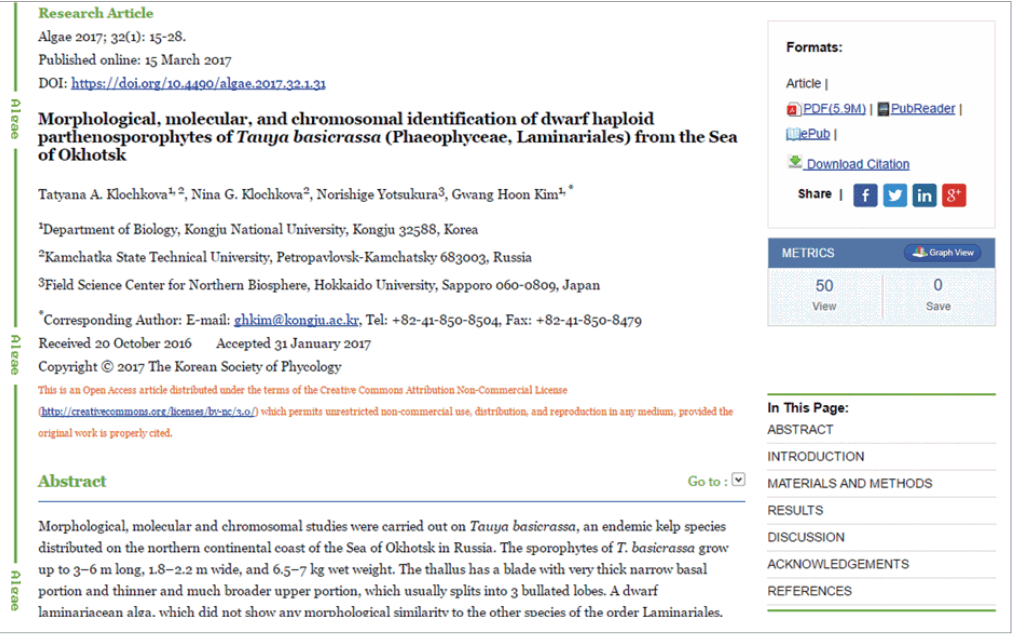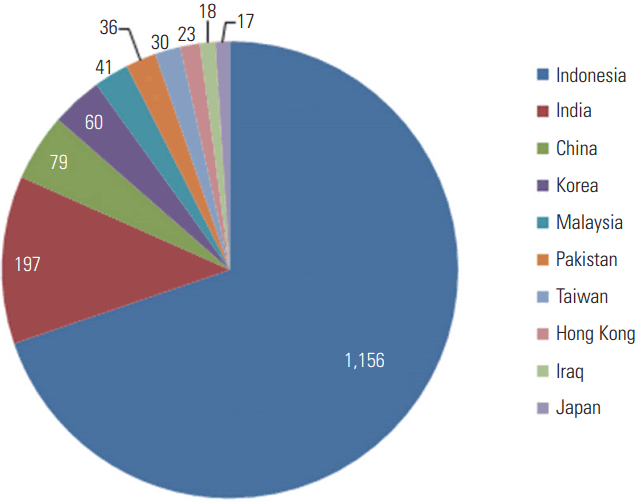Articles
- Page Path
- HOME > Sci Ed > Volume 5(1); 2018 > Article
-
Review
Open access full-text databases in Asian countries -
Tae-Sul Seo

-
Science Editing 2018;5(1):26-31.
DOI: https://doi.org/10.6087/kcse.114
Published online: February 19, 2018
Korea Institute of Science and Technology Information, Seoul, Korea
- Correspondence to Tae-Sul Seo tsseo@kisti.re.kr
- This work is a revision of the work presented at the fourth Asian Science Editors’ Conference and Workshop in Ho Chi Minh, Vietnam in July 7, 2017.
• Received: December 28, 2017 • Accepted: January 10, 2018
Copyright © 2018 Korean Council of Science Editors
This is an open access article distributed under the terms of the Creative Commons Attribution Non-Commercial License (http://creativecommons.org/licenses/by-nc/4.0/), which permits unrestricted use, distribution, and reproduction in any medium, provided the original work is properly cited.
Abstract
- Open access promotion methods are generally divided into the ‘gold road’ and the ‘green road.’ Asian countries most commonly focus on the gold road while others focus on the green road. According to data from the Directory of Open Access Journal and the Directory of Open Access Repositories, Indonesia has the largest number of open access journals in the world, while Japan has the third largest number of institutional repositories. In contrast, in Korea, the extensible markup language services of the original text of journal articles are more popular than other Asian countries. In this article, the current status of open access in Asian countries is investigated, and typical open access journal service platforms in Asian countries are reviewed.
- Open access of academic journals has been promoted in order to allow anyone, without financial, legal, or technical barriers, to access journal articles that could not otherwise be read due to expensive subscription fees [1]. However, another important reason why many countries in Asia are interested in open access journals is to increase the accessibility and visibility of their journals [2,3]. The Asian region is rapidly increasing in prominence on the world stage, both in terms of research activity as well as scientific production. In terms of research outputs, the Asian region is already prolific and is growing quickly [4]. In contrast, the share of journals published by Asian countries in international indexes such as Science Citation Index and Scopus is relatively low. Thus, open access is a good way for Asian countries to increase the visibility of their journals.
- In this article, the current status of open access in Asian countries is investigated using data from the Directory of Open Access Journal (DOAJ, https://doaj.org) and the Directory of Open Access Repositories (OpenDOAR, http://www.opendoar.org), and typical open access journal service platforms in Asian countries, including full text articles, are reviewed.
Introduction
- There are 2 representative open access sites, DOAJ and Open-DOAR. DOAJ provides country-specific statistics for open access journals, while OpenDOAR provides national and continental statistics for institutional repositories.
- DOAJ was launched in 2003 at Lund University, Sweden. It is a community-curated list of open access journals and aims to be the starting point for all information searches for quality, peer reviewed open access material [5]. Over 10,000 open access journals from around the world are included in DOAJ.
- OpenDOAR provides a quality-assured listing of open access repositories around the world. OpenDOAR staff harvest and assign metadata to allow categorisation and analysis to assist the wider use and exploitation of repositories. It is maintained by the Centre for Research Communications at the University of Nottingham, United Kingdom [6].
- Fig. 1 shows the current status of the Asian journals registered with DOAJ. Indonesia, India, and China have many journals registered with DOAJ. Indonesia has the largest number of open access journals in the world. In Indonesia, which has the fourth largest population in the world, all undergraduate and graduate students are required to publish 1 or more journal articles before final examinations [4]. Therefore, many journals exist and the number of open access journals is also greater than that of other countries.
- India and China are the next largest number of journals registered with the DOAJ, but they are relatively small compared to the country size, and it is rather remarkable that Korea is the fourth. The reason for this is that the evaluation of academic journals in Korea gives an advantage to open access. Therefore, Korean academic societies became interested in open access to get the better grades in the evaluation.
- Fig. 2 shows the statistics from OpenDOAR, a directory of open access repositories. Asia accounts for 20.2% of such repositories, following Europe. Japan has the most repositories among Asian countries because the Japanese government has been investing in the construction of institutional repositories since 2006. In return for receiving funds through a public contest, universities are required to make practical suggestions based on their experience in operating the institutional repositories [3]. Various types of academic content have been deposited in the institutional repositories, including journal articles. Snice 2012, National Institute of Informatics (NII) has provided universities Japanese Institutional Repositories Online (JAIRO) cloud service, which is a shared institutional repository using WEKO system, repository software developed by NII. As of September 2017, 811 institutional repositories are installed in Japan.
Current Status of Open Access in Asian Countries
- Overview
- As with other regions, open access policies and practices are being adopted in Asia, although progress varies greatly across the different countries [7]. Many Asian countries do not only have a cohesive national open access strategy, but also lack funding to develop the infrastructure needed to support open access. As a result, open access activities are uncoordinated, which ultimately reduces their impact [4].
- In this article, cases of countries that have relatively well established open access journal sites were introduced for reference in other countries. The Asian countries that operate well established national platforms of open access journals are Korea, China, and Japan. Therefore, this article introduces the major journal service platforms of these 3 countries.
- Korea
- Korea has been interested in open access since the early 2000s, but since 2009, research and business related to open access have begun. The Korea Institute of Science and Technology Information was the first institution to build open access infrastructure as a national center of scientific and technological information in Korea. The Korean Federation of Science and Technology (KOFST) have been supporting open access journals. In the private sector, the Korean Association of Medical Journal Editors has been built journal database in the field of biomedical sciences.
- In 2007, Korean Association of Medical Journal Editors launched KoreaMed Synapse (Fig. 3), the first Korean open access journal platform including approximately 130 Korean biomedical journals with full text articles in the form of Journal Article Tag Suite (JATS) extensible markup language (XML) [8]. KoreaMed Synapse, a reference linking platform using Crossref’s DOI (digital object identifier), was developed to be compatible with PubMed Central.
- In the field of science and technology, Korea Institute of Science and Technology Information has been building an open access journal platform known as KPubS (Fig. 4) since 2014. KPubS originally provided only XML full text journals [9], but in 2016 it has expanded to open access PDF journals. As of 2017, KPubS includes 115 journals.
- KOFST provides advantages to open access journals in the evaluation of journal support. Therefore, Korean academic societies became interested in open access to receive support from KOFST. Since Korean journals were mostly free access, it was easy to change to open access by just adopting an open access license such as Creative Commons Licenses. KOFST also operates a PubMed Central-compatible journal site called ScienceCentral that includes about 140 journals (Fig. 5).
- In summary, almost all Korean open access journal platforms contain journals published in English or Korean, the interfaces are English, and full texts are in the form of JATS XML.
- China
- In early 2000s, the Chinese Academy of Sciences, and the Natural Science Foundation of China signed the Berlin Declaration. In 2010, the 8th Berlin Open Access Conference—the first one held outside of Europe—was held in Beijing. Like this, Chinese scientific communities have been very active in the promotion of open access [10]. However, China has also an open access journal service known as China Open Access Journals, operated by Chinese Academy of Sciences. It includes over 600 Chinese journals in all disciplines. The interface is Chinese and readers can get the full texts through the links provided (Fig. 6).
- To overcome low global visibility of Chinese-language open access journals, it is suggested that the publishers participate in the worldwide network of scholarly publishing, and engage in more interaction with their counterparts outside China so that they can be a part of a global publishing community, keeping a sharp eye on new trends in journal publishing [11].
- Japan
- The situation of scholarly publishing in Japan is similar to those of Korea and China. Scholarly Publishing and Academic Resources Coalition (SPARC) Japan has been launched in 2003 by NII in order to promote open access journals it [12]. After that, open access policy was adopted by Japanese government in 2013. The Japan Science & Technology Agency operates J-STAGE, which includes over 2,000 science and technology journals published in Japan. J-STAGE currently has a Japanese-language interface (Fig. 7). Japan Science & Technology Agency has been using J-STAGE as open access journal platform [13], and a new English-language interface is opened recently.
Open Access Journal Databases in Asian Countries
- In this article, the current status of open access in Asian countries was investigated with data from DOAJ and OpenDOAR and typical open access journal service platforms in Asian countries are introduced. Indonesia has the largest number of open access journals of any country in the world, while Japan has the third largest number of institutional repositories. Meanwhile, in Korea, XML services of full texts are more popular than other Asian countries.
- Other Asian countries do not seem to establish open access infrastructure well. Therefore, it is necessary to develop the open access infrastructure through cooperation between the countries where open access infrastructure is relatively good and those that are not. For example, it would be desirable to work together through editors’ communty such as the Council of Asian Science Editors or through councils like Asia Open Access.
Conclusion
-
Acknowledgements
- This work was supported by a research grant from the Korea Institute of Science and Technology Information (K-18-L02-C01 S&T Contents Construction and Service).
Fig. 2.Open access repositories (A) by continent and (B) by country in the Directory of Open Access Repositories (OpenDOAR).


Fig. 3.KoreaMed Synapse (https://synapse.koreamed.org), operated by the Korean Association of Medical Journal Editors.


Fig. 4.KPubS (http://www.kpubs.org), operated by the Korea Institute of Science and Technology Information.


Fig. 5.ScienceCentral (https://e-sciencecentral.org), operated by the Korean Federation of Science and Technology.


Fig. 6.China Open Access Journals (http://www.oaj.cas.cn) operated by the Chinese Academy of Sciences [access on 2017 Dec 23].


- 1. Budapest Open Access Initiative. Read the original BOAI declaration [Internet]. Budapest Open Access Initiative; 2002 [cited 2017 Dec 26]. Available from: http://www.budapestopenaccessinitiative.org/read.
- 2. Seo TS, Choi HY. Global dissemination of domestic scholarly journals using DOI and open access. J Inf Manag 2011;42:1-21.https://doi.org/10.1633/JIM.2011.42.4.001. Article
- 3. Cho J. Exploratory analysis of the operation of institutional repositories in Asian countries. Inf Dev 2017;Nov. 14. [Epub]. https://doi.org/10.1177/0266666917742442. Article
- 4. Asian Open Access. Country activities survey [Internet]. COAR; 2017 [cited 2018 Jan 10]. Available from: https://www.coar-repositories.org/files/Asia-OA-survey-results-June-15-2017.pdf.
- 5. Directory of Open Access Journals (DOAJ). About DOAJ [Internet]. DOAJ; [cited 2018 Jan 10]. Available from: https://doaj.org/about.
- 6. Directory of Open Access Repositoris (OpenDOAR). About OpenDOAR [Internet]. Nottingham: OpenDOAR; 2014 [cited 2018 Jan 10]. Available from: http://www.opendoar.org/about.html.
- 7. Wiryawan KG. The current status of science journals in Indonesia. Sci Ed 2014;1:71-5.https://doi.org/10.6087/kcse.2014.1.71. ArticlePDF
- 8. National Information Standards Organization. ANSI/NISO Z39.96-2012, JATS: Journal Article Tag Suite (version 1.0) [Internet]. Baltimore, MD: National Information Standards Organization; [cited 2018 Jan 10]. Available from: http://groups.niso.org/apps/group_public/document.php?document_id=10591.
- 9. Park M, Seo TS. Creating a national open access journal system: the Korean journal publishing service. J Sch Publ 2016;48:53-67.https://doi.org/10.3138/jsp.48.1.53. Article
- 10. Zhang X. Development of open access in China: strategies, practices, challenges. Insights 2014;27:45-50.http://doi.org/10.1629/2048-7754.111. Article
- 11. Shen C. Open access scholarly journal publishing in Chinese. Publications 2017;5:22. http://doi.org/10.3390/publications5040022. Article
- 12. SPARC Japan. About us [Internet]. Tokyo: National Institute of Informatics; 2017 [cited 2018 Jan 10]. Available from: http://www.nii.ac.jp/sparc/en/about/.
- 13. Japan Science and Technology Agency (JST). JST policy on open access [Internet]. Tokyo: JST; 2013 [cited 2018 Jan 10]. Available from: https://www.jst.go.jp/EN/about/pdf/OpenAccessPolicy.pdf.
References
Figure & Data
References
Citations
Citations to this article as recorded by 

- Open access initiatives in European countries: analysis of trends and policies
Mohammad Nazim, Raj Kumar Bhardwaj
Digital Library Perspectives.2023; 39(3): 371. CrossRef - Proposal for the development of a national open access database in Vietnam and comparison with other Asian countries’ national literature databases
Loc My Thi Nguyen, Tien-Trung Nguyen, Thanh Thi Nghiem, Hien Thu Thi Le, Thao Phuong Thi Trinh, Thuan Van Pham, Thanh Chi Nguyen, Linh Khanh Hoang, Trung Tran
Science Editing.2020; 7(1): 55. CrossRef - Otwarty dostęp w krajach globalnego Południa
Małgorzata Glinicka
Zagadnienia Informacji Naukowej - Studia Informacyjne.2020; 58(1(115)): 56. CrossRef - CJK Languages or English: Languages Used by Academic Journals in China, Japan, and Korea
Xiaomei Liu, Xiaotian Chen
Journal of Scholarly Publishing.2019; 50(3): 201. CrossRef - Comprehensive Approach to Open Access Publishing: Platforms and Tools
Armen Yuri Gasparyan, Marlen Yessirkepov, Alexander A. Voronov, Anna M. Koroleva, George D. Kitas
Journal of Korean Medical Science.2019;[Epub] CrossRef - Latest trends in innovative global scholarly journal publication and distribution platforms
Soon Kim, Eunkyung Chung, Jae Yun Lee
Science Editing.2018; 5(2): 100. CrossRef

 KCSE
KCSE


 PubReader
PubReader ePub Link
ePub Link Cite
Cite








